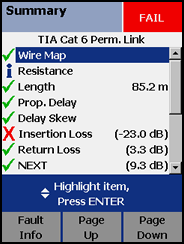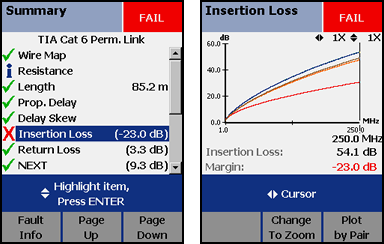ケース・スタディ 4 - 潤滑油に起因する挿入損失不良:DTX CableAnalyzer
|
A Youtube video is also available on this subject. In this case study, the installer was failing Insertion Loss when certifying a number of category 6 permanent links. After the AUTOTEST, the installer was presented with the following DTX CableAnalyzer test result.
If you are not familiar with Insertion Loss traces, the four colored lines (four pairs of the cable) should be below the red limit line. This is an extreme failure. The traces are nice and smooth, indicating that there are no significant impedance mismatches in the cable. Could this excessive Insertion Loss be caused by temperature? When temperature increases, so does the Insertion Loss of the cable. The TIA gives a formula so we could calculate how hot it would need to be to get an Insertion Loss reading this bad. The TIA states that; "......using a factor of 0.4 % increase per °C from 20 °C to 40 °C and 0.6% increase per °C for temperatures from 40 °C to 60 °C." At 85.2 m we would normally expect an Insertion Loss value of around 29.4 dB @ 250 MHz. We know the temperature in this installation is no hotter than 60 °C. At 60 °C we would expect the Insertion Loss to be 33.3 dB @ 250 MHz based on the TIA formulae, but our Insertion Loss here is much higher at 54.1 dB @ 250 MHz. When Insertion Loss fails this badly and all other parameters pass, the most likely cause of failure is the use of lubricant. Lubricant used for pulling cable is typically highly conductive. If the lubricant has not been given time to "cure", the electrons flowing down the pairs in the cable will be pulled out of the cable and into the lubricant surrounding the cable. The HDTDR will not help with lubricant issues. If you have "Store Plot Data" enabled in your DTX CableAnalyzer, these graphs will be available to analyze in LinkWare PC Software. まとめ: It's a waiting game for the lubricant to "cure". The Insertion Loss will get better with time. And in this case, it did. ヒント: Since Insertion Loss is a function of length, we can make some predictions. The example here is as bad as it gets. We can estimate the loss of the cable to be (54.1 dB @ 250 MHz / 85.2 m) approx. 0.635 dB/m when this lubricant is used. The Category 6 Insertion Loss limit at 250 MHz is 31.1 dB. We can therefore expect to run into problems with lubricant after (31.1 dB / 0.635) 50 meters. You may wish to investigate the use of an alternative lubricant if you do not have time for it to cure. An example would be Polywater® FTXX Pulling Lubricant. |






